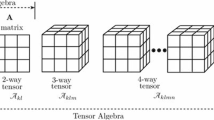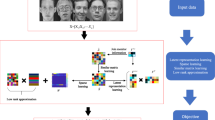Abstract
Collaborative representation-based classification (CRC) is one of the famous representation-based classification methods in pattern recognition. However, a testing sample in most of the CRC variants is collaboratively reconstructed by a linear combination of all the training samples from all the classes, the training samples from the class that the testing sample belongs to have no advantage in discriminatively and competitively representing and classifying the testing sample. Moreover, the incorrect classification can easily come into being when the training samples from the different classes are very similar. To address the issues, we propose a novel discriminative collaborative representation-based classification (DCRC) method via \(l_2\) regularizations to enhance the power of pattern discrimination. In the proposed model, we consider not only the discriminative decorrelations among all the classes, but also the similarities between the reconstructed representation of all the classes and the class-specific reconstructed representations in the \(l_2\) regularizations. The experiments on several public face databases have demonstrated that the proposed DCRC effectively and robustly outperforms the state-of-the-art representation-based classification methods.













Similar content being viewed by others
References
Zhang, L, Yang, M, Feng, X (2011) Sparse representation or collaborative representation: Which helps face recognition? In: International conference on computer vision (ICCV2011), pp 471–478
Yang M, Zhang L, Zhang D (2012) Relaxed collaborative representation for pattern classification. In: IEEE conference on computer vision and pattern recognition (CVPR), pp 2224–2231
Zhu P, Zhang L, Hu Q (2012) Multi-scale patch based collaborative representation for face recognition with margin distribution optimization. In: European conference on computer vision (ECCV). Springer, Berlin, Heidelberg, pp 822–835
Chi Y, Porikli F (2014) Classification and boosting with multiple collaborative representations. IEEE Trans Pattern Anal Mach Intell 36(8):1519–1531
Li W, Du Q (2015) Collaborative representation for hyperspectral anomaly detection. IEEE Trans Geosci Remote Sens 53(3):1463–1474
Yang W, Wang Z, Sun C (2015) A collaborative representation based projections method for feature extraction. Pattern Recognit 48(1):20–27
Yang M, Wang X, Zeng G (2017) Joint and collaborative representation with local adaptive convolution feature for face recognition with single sample per person. Pattern Recognit 66:117–128
Su H, Zhao B, Du Q (2018) Multifeature dictionary learning for collaborative representation classification of hyperspectral imagery. IEEE Trans Geosci Remote Sens 56(4):2467–2484
Zheng C, Wang N (2019) Collaborative representation with k-nearest classes for classification. Pattern Recognit Lett 117:30–36
Zeng S, Zhang B, Lan Y, Gou J (2018) Robust collaborative representation-based classification via regularization of truncated total least squares. Neural Comput Appl. https://doi.org/10.1007/s00521-018-3403-7
Deng W, Hu J, Guo J (2018) Face recognition via collaborative representation: its discriminant nature and superposed representation. IEEE Trans Pattern Anal Mach Intell 40(10):2513–2521
Cai S, Zhang L, Zuo W (2016) A probabilistic collaborative representation based approach for pattern classification. In: IEEE conference on computer vision and pattern recognition (CVPR). IEEE Computer Society, pp 2950–2959
Yang W, Wang Z, Yin J (2013) Image classification using kernel collaborative representation with regularized least square. Appl Math Comput 222:13–28
Su H, Zhao B, Du Q (2016) Tangent distance-based collaborative representation for hyperspectral image classification. IEEE Geosci Remote Sens Lett 13(9):1236–1240
Liu J, Wu Z, Li J (2016) Probabilistic-kernel collaborative representation for spatial–spectral hyperspectral image classification. IEEE Trans Geosci Remote Sens 54(4):2371–2384
Jiang J, Chen C, Yu Y (2017) Spatial-aware collaborative representation for hyperspectral remote sensing image classification. IEEE Geosci Remote Sens Lett 14(3):404–408
Zhu P, Zuo W, Zhang L (2014) Image set-based collaborative representation for face recognition. IEEE Trans Inf Forensics Secur 9(7):1120–1132
Zeng S, Yang X, Gou J (2017) Multiplication fusion of sparse and collaborative representation for robust face recognition. Multimed Tools Appl 76(20):20889–20907
Xu Y, Li X, Yang J (2014) Integrating conventional and inverse representation for face recognition. IEEE Trans Cybern 44(10):1738–1746
Xu Y, Zhu Q (2013) A simple and fast representation-based face recognition method. Neural Comput Appl 22(7–8):1543–1549
Gou J, Xu Y, Zhang D, Mao Q, Du L, Zhan Y (2018) Two-phase linear reconstruction measure-based classification for face recognition. Inf Sci 433:17–36
Wang W, Yan Y, Zhang L (2016) Collaborative sparse coding for multiview action recognition. IEEE MultiMedia 23(4):80–87
Gao Z, Li S, Zhu Y (2017) Collaborative sparse representation leaning model for RGBD action recognition. J Vis Commun Image Represent 48:442–452
Wright J, Yang AY, Ganesh A (2009) Robust face recognition via sparse representation. IEEE Trans Pattern Anal Mach Intell 31(2):210–227
Gou J, Hou B, Ou W, Mao Q, Yang H, Liu Y (2019) Several robust extensions of collaborative representation for image classification. Neurocomputing 348:120–133
Lan R, Zhou Y (2017) An extended probabilistic collaborative representation based classifier for image classification. In: IEEE international conference on multimedia and expo (ICME), pp 1392–1397
Wei L, Xu F, Yin J (2014) Kernel locality-constrained collaborative representation based discriminant analysis. Knowl-Based Syst 70:212–220
Liu W, Lu L, Li H (2014) A novel kernel collaborative representation approach for image classification. In: IEEE international conference on image processing (ICIP), pp 4241–4245
Liu W, Yu Z, Lu L (2015) KCRC-LCD: discriminative kernel collaborative representation with locality constrained dictionary for visual categorization. Pattern Recognit 48(10):3076–3092
Chen S, Li S, Ji R (2016) Discriminative local collaborative representation for online object tracking. Knowl-Based Syst 100:13–24
Timofte R, Van Gool L (2014) Adaptive and weighted collaborative representations for image classification. Pattern Recognit Lett 43:127–135
Peng X, Zhang L, Zhang Y (2014) Learning locality-constrained collaborative representation for robust face recognition. Pattern Recognit 47(9):2794–2806
Waqas J, Yi Z, Zhang L (2013) Collaborative neighbor representation based classification using \(l_2\)-minimization approach. Pattern Recognit Lett 34(2):201–208
Jin T, Liu Z, Yu Z (2016) Locality preserving collaborative representation for face recognition. Neural Process Lett 45(3):1–13
Huang W, Wang X, Jin Z (2015) Penalized collaborative representation based classification for face recognition. Appl Intell 43(4):722–731
Dong X, Zhang H, Zhu L (2019) Weighted locality collaborative representation based on sparse subspace. J Vis Commun Image Represent 58:187–194
H Li, M Yang (2017) Joint collaborative representation with deep feature for image-set face recognition. In: Chinese conference on biometric recognition. Springer, Cham, pp 172–182
Zeng S, Zhang B, Zhang Y, Gou J (2018) Collaboratively weighting deep and classic representation via \(l_{2}\) regularization for image classification. In: Asian conference on machine learning, pp 502–517
Vo DM, Lee SW (2018) Robust face recognition via hierarchical collaborative representation. Inf Sci 432:332–346
Zeng S, Gou J, Yang X (2018) Improving sparsity of coefficients for robust sparse and collaborative representation-based image classification. Neural Comput Appl 30(10):2965–2978
Akhtar N, Shafait F, Mian A (2017) Efficient classification with sparsity augmented collaborative representation. Pattern Recognit 65:136–145
Yang M, Zhang L, Feng X (2011) Fisher discrimination dictionary learning for sparse representation. In: IEEE international conference on computer vision (ICCV), pp 543–550
Wu Y, Li W, Mukunoki M (2014) Discriminative collaborative representation for classification. In: Asian conference on computer vision. Springer, Cham, pp 205–221
Xu Y, Zhong Z, Yang J (2017) A new discriminative sparse representation method for robust face recognition via \(l_ {2}\) regularization. IEEE Trans Neural Netw Learn Syst 28(10):2233–2242
Gou J, Wang L, Yi Z, Lv J, Mao Q (2018) A new discriminative collaborative neighbor representation method for robust face recognition. IEEE Access 6:74713–74727
Zeng S, Gou J, Deng L (2017) An antinoise sparse representation method for robust face recognition via joint \(l_{1}\) and \(l_{2}\) regularization. Expert Syst Appl 82:1–9
Yuan H, Li X, Xu F et al (2018) A collaborative–competitive representation based classifier model. Neurocomputing 275:627–635
Chi H, Xia H, Zhang L (2018) Competitive and collaborative representation for classification. Pattern Recognit Lett. https://doi.org/10.1016/j.patrec.2018.06.019
Deng Y, Bao F, Kong Y, Ren Z, Dai Q (2017) Deep direct reinforcement learning for financial signal representation and trading. IEEE Trans Neural Netw Learn Syst 28(3):653–664
Li Z, Liu J, Tang J, Lu H (2015) Robust structured subspace learning for data representation. IEEE Trans Pattern Anal Mach Intell 37(10):2085–2098
Deng Y, Ren Z, Kong Y, Bao F, Dai Q (2017) A hierarchical fused fuzzy deep neural network for data classification. IEEE Tran Fuzzy Syst 25(4):1006–1012
Tariyal S, Majumdar A, Singh R, Vatsa M (2016) Deep dictionary learning. IEEE Access 4:10096–10109
Deng Y, Bao F, Deng X, Wang R, Kong Y, Dai Q (2016) Deep and structured robust information theoretic learning for image analysis. IEEE Trans Image Process 25(9):4209–4221
Manjani I, Tariyal S, Vatsa M, Singh R, Majumdar A (2017) Detecting silicone mask-based presentation attack via deep dictionary learning. IEEE Trans Inf Forensics Secur 12(7):1713–1723
Gou J, Qiu W, Zhang Y, Xu Y, Mao Q, Zhan Y (2019) A local mean representation-based K-nearest neighbor classifier. ACM Trans Intell Syst Technol 10(3):29
Gou J, Ma H, Ou W, Zheng S, Rao Y (2019) A generalized mean distance-based k-nearest neighbor classifier. Expert Syst Appl 115:356–372
Wang H, Dai L, Cai Y, Sun X, Chen L (2018) Salient object detection based on multi-scale contrast. Neural Netw 101:47–56
Deng Y, Bao F, Yang Y, Ji X, Du M, Zhang Z, Dai Q (2017) Information transduction capacity reduces the uncertainties in annotation-free isoform discovery and quantification. Nucleic Acids Res 45(15):e143–e143
Cai Y, Liu Z, Wang H, Sun X (2017) Saliency-based pedestrian detection in far infrared images. IEEE Access 5:5013–5019
Zhan Y, Liu J, Gou J, Wang M (2016) A video semantic detection method based on locality-sensitive discriminant sparse representation and weighted KNN. J Vis Commun Image Represent 41:65–73
Li Z, Tang J, Mei T (2018) Deep collaborative embedding for social image understanding. IEEE Trans Pattern Anal Mach Intell. https://doi.org/10.1109/TPAMI.2018.2852750
Zhang M, Li W, Du Q (2018) Diverse region-based CNN for hyperspectral image classification. IEEE Trans Image Process 27(6):2623–2634
Deng Y, Zhao Y, Ren Z, Kong Y, Bao F, Dai Q (2016) Discriminant kernel assignment for image coding. IEEE Trans Cybern 47(6):1434–1445
Acknowledgements
This work was supported in part by National Natural Science Foundation of China (Grant Nos. 61502208, 61762021 and 61402122), Natural Science Foundation of Jiangsu Province of China (Grant No. BK20150522), International Postdoctoral Exchange Fellowship Program of China Postdoctoral Council (No. 20180051), Research Foundation for Talented Scholars of JiangSu University (Grant No. 14JDG037), China Postdoctoral Science Foundation (Grant No. 2015M570411), Open Foundation of Artificial Intelligence Key Laboratory of Sichuan Province (Grant No. 2017RYJ04), and Natural Science Foundation of Guizhou Province (Nos. [2017]1130 and [2017]5726-32). The authors would like to thank Jia Ke for some helpful suggestions and discussions for the revisions of this article. Furthermore, they thank the editors and reviewers for valuable comments to improve our article.
Author information
Authors and Affiliations
Corresponding author
Ethics declarations
Conflict of interest
All the authors declare that there is no conflict of interests regarding the publication of this article.
Additional information
Publisher's Note
Springer Nature remains neutral with regard to jurisdictional claims in published maps and institutional affiliations.
Rights and permissions
About this article
Cite this article
Gou, J., Hou, B., Yuan, Y. et al. A new discriminative collaborative representation-based classification method via l2 regularizations. Neural Comput & Applic 32, 9479–9493 (2020). https://doi.org/10.1007/s00521-019-04460-x
Received:
Accepted:
Published:
Issue Date:
DOI: https://doi.org/10.1007/s00521-019-04460-x




